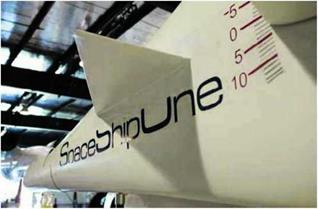Supersonic Flight Control
Similar to the Bell X-l, as shown in figure 6.6, which in 1947 was the first aircraft to break the sound barrier, SpaceShipOne used electric, motor-driven control surfaces to maneuver. After SpaceShipOne
broke the speed of sound during test flights, the subsonic flight controls no longer functioned efficiently.
“Once you are supersonic, the control system that you normally use to fly the airplane doesn’t work anymore,” Melvill said. “Because it is a mechanically controlled airplane, there is no hydraulic system like there is on an F-16 or F-l 8. It is just cables and pushrods. You are just not strong enough to move the controls at that point. So you just revert to using the trim switches.”
 Г"
Г"
![]() Fig. 6.6. Because the forces pushing against the control surfaces of the X-1 were so strong while flying at supersonic speeds, the pilot could not use conventional mechanically linked flight controls. The control surfaces had to be electrically controlled and moved using electric motors. SpaceShipOne used a similar system for flying above Mach 1. NASA-Dryden Flight Research Center
Fig. 6.6. Because the forces pushing against the control surfaces of the X-1 were so strong while flying at supersonic speeds, the pilot could not use conventional mechanically linked flight controls. The control surfaces had to be electrically controlled and moved using electric motors. SpaceShipOne used a similar system for flying above Mach 1. NASA-Dryden Flight Research Center
V________________ J
Many aircraft have trim controls that help the pilots maintain course by slightly altering control surfaces. By changing a trim setting, a pilot can fine-tune the control surfaces, so less force has to be applied to the control stick and rudder pedals in order to stay on course. SpaceShipOne uses trim controls in a somewhat similar way during supersonic flight.
A switch on the top of the control stick activated electric servos that pivoted the entire horizontal stabilizer on each side of SpaceShipOne for pitch trim. In figure 6.7, a close-up of a tail boom shows the numeric scale that indicates the amount of deflection for the horizontal stabilizer as set by the pilot.
|
|
r ; ^
Fig. 6.7. Triangular strakes were added in front of the horizontal stabilizers, which were also enlarged, to improve the aerodynamics of SpaceShipOne. The numbers to the right of the strake show the amount of trim or deflection of moveable horizontal stabilizers. Mojave Aerospace Ventures LLC, photograph by David M. Moore
V__________________ J
A knob at the pilot’s left side called the “turtle” activated the lower half of each rudder, giving yaw trim. “Yawing the airplane caused it to roll because of the high wing and the swept leading edges,” Melvill said. “We actually didn’t use the roll trim. It was too powerful. We used yaw trim to roll the plane. If it was rolling off to the left, you would yaw it to the right.”
The lower rudders were synced and moved in the same direction, unlike the upper rudders used in subsonic flight. “The geometry is such that they go out a lot and in just a little bit,” Rutan added. “But they never work opposite.”
Trimming was also used to restrict the movement of SpaceShipOne during test flights. For example, when Mission Control monitored the trajectory of SpaceShipOne, they would instruct the pilot to make trim changes in order to help him stay on course.
More than midway through the burn, the atmosphere became so thin that the supersonic flight controls were no longer needed. The pilot was able to control SpaceShipOne with subsonic flight controls, even though it was flying much faster than the speed of sound, because the rarified air produced little opposing force. When SpaceShipOne fully left the atmosphere, the pilot then switched over to the RCS.











